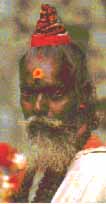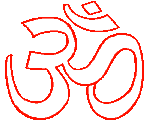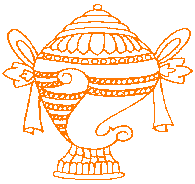CULTURE IS THE ART OF LIVING
Meditation
The Indian Rishis attributed great importance to culture and stressed on the need for the development of the inner faculties of a human being. They discovered various methods of feeding, resting and revitalizing the body. After countless years of experience and experiments they developed special systems of exercises for increasing the strength, purity and power of all the faculties of man.
The Rishis claimed that God could be attained through meditation because then the mind eventually surrenders to a thought, which is subjected to long periods of concentration without any interruptions. In meditation, the performer attains a state of communion with his deity.
The rishis also preach that for sublimation and evolution, every person must meditate on God at least three times a day. They associate these times with the three times of the Sun. When one gets up from sleep, he must pay homage to his deity or the rising Sun to prepare for the day's chores. He must respect the mid-day Sun when he prepares to eat meals for his sustenance and the setting Sun to express his gratitude to his Creator for the successful completion of his day's work. They also proclaim that the most auspicious time for meditation is 3 am every day, because during this time, Mother Nature is the most serene. It is called Brahma Muhurta.
In order to attain spiritual progress, one must try to dissociate from worldly pleasures and attachments. Hence they advocated that meditation is supposed to be performed at a predetermined place, time and location for accelerated concentration. To make this easier they constructed temples, which are highly energized holy places.
In India, saints and sages have been meditating from time immemorial and they can be still found in many holy cities and riverbanks. Most of them give up their food and clothes to attain moksha or everlasting life. Saint Vivekananda is said to have meditated in the Rock Temple in Kanyakumari, the Southern tip of India for peace. Nowadays even common Indians have started to make a beeline to Ashrams which propose to teach them meditation and concentration to attain peace in life.
Yogis or Rishis
In the Bhagavad Gita, Shree Krishna teaches Arjun that a "YOGI" is one who is joined to God. The path that leads to ideals is that of a yogi who consciously and deliberately progresses towards divinity, which is the purpose of creation. With yogic advance his mind gets purified and he later becomes a Siddha Saint.
An ascetic is one who undergoes voluntary sacrifices to obtain celestial powers, like going without food or clothes for days, standing on ones head for hours together, sleeping on a bed of nails, piercing ones body with sharp objects, etc.All those who practice meditation, concentration and purification of their mind and body senses are real Yogis. There can be no higher state than this because they are nearer to God by way of worshipping him.In worldly terms they have long hairs, and a flourishing beard and wear saffron or white or black robes.
The Sacrificial Fire
Almost most of the Indian religions worship fire as a benevolent element. From time immemorial the sacrificial fire has been an important item of our culture. Every function, ceremony, worship or Puja starts with the worship of the fire in some form or the other. Most of the Indian women perform a small worship of the deity in their house with a special "ARTI" of a small deepam or lamp and incense sticks. The importance of fire worship is mentioned in all the Vedas and religious books.
Some modern thoughts regard the Fire Worship as a primitive practice of campfire. But scientists have established that performing a small domestic "havan" or fire worship with ghee and other specified ingredients produces purifying gases like ethylene oxide, propylene oxide, formaldehyde, butapropiolactone and acetylene which boost up the spirit of the performer and the surroundings.

Rishis perform Havan in the ashrams to purify it and give it an atmosphere of good health and prosperity. Fire worship is done in India, for prosperity, health, victory, thanksgiving, good crop, bountiful rain, etc. Twigs and dried leaves of some special trees, rice, wheat, til seeds, guggal, camphor, raisins, coconut, vermilion and turmeric are used for the fire worship. Guggal and Camphor are supposed to be good germ-killers. The burning of these items in the fire along with the addition of pure ghee and the reciting of Mantras produces beneficial gases according to the Rishis. They prescribe the morning or evening as the ideal time for performing this worship. But the Tantriks prefer to perform their Yagna at midnight, nearest to a cremation ground!
Deepam or Lamp

The Rishis of India worship FLAME or JYOTI or DEEPAM, as being the purest of the pure because it consumes all impurities but yet remains pure by itself.
A lamp is an earthen saucer like container, filled with ghee or butter with a twisted cotton tape immersed in it. It is lighted in every Hindu household and temple in India. The cotton tape keeps sucking the ghee to yield a cool bright light, a flame.In nature the flame is considered to be the source of infinite energy of positive currents. If even number of lamps is kept side by side, they cancel each other's radiation and become harmful. This explains the use of odd number of lamps for worship.
Great emphasis is also placed on performing "ARTI" in India during worship of any deity. The arti flame is moved around the idol for the devotees to have a good look of the deity, then the devotees put out their palms to receive the arti aura, when their body's energy rises to the level of the flame according to researchers. The flame is also considered a good germ killer.
Tree worship
Trees are considered to be friends of man as they provide him shelter, food, fuel, and oxygen for good living. In the Rigveda and the Atharveda some trees are deified, as "Vriksha Devta" which are considered to be holy and the people ought to worship them. The Pipal, Banyan, Goolar, Amla, Vilva, Sandal, Neem, Mango, and Babool are the trees that are worshipped in India.
It is said that Gods and the souls of pious ancestors rest on the branches of the Pipal tree and so it is not a domestic tree, instead it is grown in temples and inns where people come to worship. The Pineal gland's secretions of humans make their brains alert and alive. The chemical found in this secretion is also found in the Pipals' juice according to scientists and hence it is called the Bodhi Vriksha.
The Banyan tree is of specialty because it sends sap from above to the earth. This resembles the functioning of the world, as it also needs sap or energy for its survival from above, God. Married Hindu ladies worship the Banyan tree for a long and happy married life.
Lord Shiva patronizes the Vilva tree as the only tree, which has three, leaves that sprout together like a trident. The juice of the leaves is a relief to the Diabetics, and the pulp of the fruit is supposed to stop diarrhea. The fruit called bel was a favorite of Lord Shiva.
Another tree is the Asoka tree which is known to relieve the worries of the persons sitting under its shade. Sita is said to have been seated under an Asoka tree in Lanka during her captivity.
The Hindus also worship the Kadam tree, because Shree Krishna used to sit and play under this tree.
Rishi Chyavan patronized the Amla tree for rejuvenating properties.
Tulsi worship
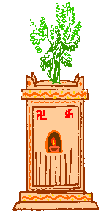
According to popular Indian belief, Wherever Tulsi is planted, the place becomes, sanctified as a place of pilgrimage and the sepoys of Lord Death dare not enter that place. In India, the Tulsi is regarded as the most sacred plant. It is a much- branched erect bushy plant of about 4 feet height. Its leaves are aromatic and they have minute glands. The flowers are purple in small clusters and the seeds are yellow are red.
According to scientists the place containing tulsi plant becomes pollution free. The oil of the leaves is capable of destroying bacteria and insects. The leaves have mercury traces and are hence nowadays used in cancer curing Ayurvedic medicines. The juice of the leaves cures bronchitis and stomach upsets. The leaves' paste cure all skin diseases and the decoction of the leaves cures common cold.
Thick branches of Tulsi are dried and cut into beads to make rosary beads, are else they are made into necklaces which the devotees wear with faith. The ancient Rishis have ordained that if a ghee lamp or incense stick or flowers are not available for performing puja then Tulsi leaves can be used and this explains the importance of the worship of tulsi in India.
Betel Leaf (Paan)

During worship or rituals, leaves from some select trees are used as essential accessories, but among them all the Betel Leaf enjoys a place of pride in India. In Hindu weddings, a betel leaf is tucked into the headgear of the bride and the groom. The use of betel leaf is considered as a noble trait and on all auspicious celebrations, betel leaf has become a symbolic item denoting freshness and prosperity.
The Skanda Purana says that the Betel Leaf was obtained during the ocean- churning by the Gods. The use of Betel Leaf in India is mentioned in the great epics, The Ramayana and the Mahabharatha as well as in Buddhist and Jain literatures.
Paan has rich herbal properties. It is invigorating and energizing, a killer of germs and bacteria and an eliminator of cold. Before eating a paan, the stalk has to be cut, the edges have to be trimmed and the veins have to be scrapped because they may damage the brain. There are whitish and blackish betel leaves. The black variety is said to be constipative and the white one eliminates cold and is a digestive.
Coconut (Nariyel) in rituals

In India, for success and prosperity on all occasions, the beginning is done with the breaking of a sanctified coconut. All religious functions and rituals start with the worship of the coconut since it is regarded as the symbolic GANESH, the deity who helps in the successful completion of any work undertaken.
Sage Vishwamitra is said to be the creator of coconut. Its hard kernel inspires one to do hard work for attaining success. People get strength and improved eyesight by eating the kernel. The sick and the elderly find its water nourishing and ladies apply its oil for luxurious hair. It has glucose, phosphorous and carbohydrates in good measures and so it is good for Diabetics. Germs can't penetrate its hard kernel so it remains intact for months together.
Ancient Indian doctors used to burn its outer shell to prepare tooth powder, eyebrow creams and ointments for burns. Every inch of the coconut plant is very beneficial to humans. Hence Indians consider it a good omen to receive or give coconut fruits as gifts. It is also called Shreephal because it denotes prosperity.
Lotus Flower
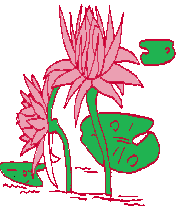
Lotus is a very important symbol of Indian cultural heritage. It is mentioned in all the Hindu scriptures because it is very sacred to the Gods. God Brahma and Buddha are depicted as seated on a Lotus flower. Lord Vishnu holds a lotus in one of his hands and Goddess Lakshmi also holds a Lotus flower. The Lotus is an appropriate symbol of detachment from the surroundings, be it good or bad.
The Indian Poets have used the Lotus as a simile in praise of the feet of the Gods and Goddesses. All the Vedas sing in praise of the Lotus. In the Yogasastra, the six Chakras are depicted with the Lotus as the base. According to the Mahayana sect of Buddhism, all the souls originate from the Lotus.
In India, the Muslim rulers used the Lotus in their architecture, an influence of Hindu architecture since the Muslims have no special significance for the Lotus. The dome of the Taj Mahal resembles an upside-closed lotus, resting on its petals. The lotus blooms with the morning light and closes its petals when the sun goes down. So the sages accepted lotus as a unique symbol of unfolding the spiritual qualities of man with the advent of light.
AUM
According to the Hindu Yogis in India, inhaling air generates SH-Sh sound while exhaling is associated with HM-HM and enunciated that SOHAM is the keynote of life. Later they discovered that sound O was guttural and sound AM touched palate and so told that AUM encompassed man's total existence.
The Aum sound is vibrating throughout the cosmos and it has three manifestations; those of creations, preservations and destruction. Every time a person utters any letter or word, he puts into operation any of these three virtues of AUM. The vibratory cosmic energy- AUM does not maintain by food alone, but man's body battery. This invisible power flows through the human body and controls its actions when uttered properly with reverence and concentration.
Tilak or Dot or Bindi
The starting point of all shapes and forms is a point. Geometry describes the point as one, which has no dimensions, but it still exists.A dot or point is the seed of language expressed by sound, so it is the finale of the highest attainment.
A dot or point is the abode of Shiva and Shakthi.Ancient Indian had an indomitable urge to communicate his thoughts and so symbols were developed. Similar group of men and women adopted different types of Tilak or linear symbols, which were further, segregated fro man and woman to wear on their body to denote their sect and ideology.
A deep study of human anatomy reveals that the forehead is the best place for applying Tilak. Rishis declared that the junction of the nose-root and the meeting point of the eyebrows is the most sensitive part of the body. The Agya- chakra, or Wheel of wisdom, is located here and so is a vulnerable spot, which must be kept, warm and protected.
The most popular forms used or a dot, or a "U" shape or a trident shape or 3 horizontal lines with a dot at the center called Tripund on the forehead and forearms. The wearers are advised by the rishis to use a mixture of vermillion, lime, turmeric, saffron, musk, agar, sandal and ash for men and sindur or vermillion on their skull-center for the women, to provide warmth to the pineal and pituitary glands located near the Thalamus.
The bindi is declared to be very helpful for the good health of the brain, eyes, ears and the nose because these applications maintain a fine pull on the veins and nerves underneath the forehead, nose-root and forearm's skin to monitor proper flow of blood. The forebrain controls the decision making part of the brain. In acupressure methods it is considered to be the most sensitive part of the body responsible for alertness and hence the use of Bindi for the forehead is justified.
Swastik

Mostly the business community considers the Swastik symbol as the symbol of all- round prosperity in India. The root of SWASTIK is SU+US; SU means benefic and US means existence; so whosoever desires to have glory, prosperity, progress and success is advised to invoke the Swastika Yantra.
The Aryans adopted the Swastik as a symbol for the good of humanity. Then the Hindus added some more arms to the Swastik to denote happiness in married life and worldly successes.
The sides of the Swastik arms must remain on the right side, moving or stationary for positive vibrations and benevolent results. BOVIS is a measure of the energy levels that surround men or materials and the Swastik is supposed to have a formidable energy of one million bovis, but in an inverse direction, the results become negative.
Indian Siddhants say that the center of the Swastik represents the uterus, the origin point of the Universe, the vertical line, Shiva and the horizontal line, the female organ. Their cross forms the origin and evolution of the whole world.
Certain shapes represent deities and when a devotee invokes the deity through the symbol, his thoughts are concentrated and good results are got and one such omnipotent symbol is the Swastik, which is widely used in India.
Rudraksha Mala
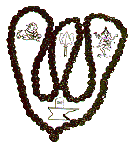
t is a common sight in India, to see saints and rishis wearing small ball-like seeds in a string around their neck. They are called Rudraksha Mala and a visit to any holy place in India, can take you to shops that sell these bead-necklaces in all colors and prices.
Rudraksha is the seed of a fruit of a rare species of a tree found in Karnataka and in the Konkan area. It is roundish with a cellular demarcation and has a central bore. Each seed may have 1 to 21 cells and the seeds with one cell are of great sanctity value. The most common variety is the seeds with 5 cellular divisions.
It has a beneficial property of attracting healthy vibrations and so saints and rishis wear them as necklaces. The Lord Shiva is also found to wear one such thing in his neck. A real rudraksha seed shall sink in water and so fake ones can be differentiated easily.
Its aromatic property helps a devotee to get into deep meditation easily. Rudraksha seeds are not supposed to be rubbed often because then they lose their charm properties. It should be worn on the neck, threaded by gold, silver or woolen threads, so that it remains in gentle touch with the body, which increases the body's immunity.
The rudraksha thread protects the wearer from lightings, accidents and brings him good luck according to Indian saints and rishis. People with positive currents of energy should wear it on their right hand and those with negative energy current on their left hands, for good results.
Sacred Thread
The Brahmanas and some sects of artisans wear the Sacred Thread as a symbol of their holiness when compared to the common man. They are considered to be next to God. In India, a tuft of hair in the back of the head, a rosary in the hand, a prominent bindi on the forehead and a sacred thread along the torso are considered to be some of the important symbols of holiness among the Hindus.
The sacred thread consists of hand -spun yarn. Three equal lengths of the yarn are twisted to form one length. After a sacred thread ceremony the person is given a sacredness status. He is supposed to wear it as a cross-belt on his body.
The three twisted yarns represent the Trinity of God, or the three virtues of life namely; pious living, imperious living and vicious living. The 3*3 also represents the Navagraha or the nine planets and also the nine outlets of the human body. The threads are bright white and so they also add to the aura and moral strength.
In India, the Zoroastrians wear such a sacred thread around their lumbar region. According to their belief, the belt keeps their lumbar region vertebras in position and gives proper alignment.
Kalash (Sacred Pot)
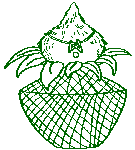
In ancient times, the rishis of India placed copper pots atop temple pinnacles to escape the calamity of lightning. But fungus developed on the pots and reduced their efficiency and so they gold-enameled the pots with gold.
The Rishis wanted water all year round to quench their thirst, so they developed a container- a Kalash and they were happy that they could enshrine God Varun in the Kalash and thus the worship of Varun started with the worshipping of the Kalash. The Rishis also ordained that every ceremony should start with the worship of the Kalash.
According to Indian mythology, The mouth of the Kalash represents Vishnu, the throat - Lord shiva, Lord Brahma adores the base and at the belly all Goddesses are established and thus in a small pot they established the presence of all gods and goddesses.
In India, on most of the ceremonial occasions, a pot filled with clean water, with fresh mango or betel leaves placed at the mouth and a coconut placed on top is kept near the entrance. It is also decorated with Swastik symbol and other ornamentations.
Ringing of bells

Centuries ago in India, the Gurukul system of education- residential Institutions for overall development of students, were situated in forests away from the crowded townships. There the insiders were constantly under beastly attacks and so bells were rung on the sighting of deadly animals to frighten them off. The metallic sounds were also found to attack bacteria and germs through scientific research.
To create very effective sound, a bell was found to be the best device since when it is made of 8 different metals, it produced the most resounding echo, which can spread in all directions. In India, regular rhythmic ringing of heavy and light weight bells has been made compulsory during the time of worship in most of the temples, so as to invoke the deity's blessings.
Research has proved that that the sound of a standard bell can cure physical as well as mental diseases. Loud sounds of the bell or the blowing of the conch, gets 27 cubic feet of air in an area of 1220 sq.ft, purified and it is taken to be the most economical way of purifying the environment.
For worship, blowing of conch, a type of shell, bells of different dimensions, the beating of metallic-alloy plates, Jhang, Majira, etc are very common in India.
Conch shells (Shankh)
The Conch Shell or Shankh was obtained as a gift from the ocean - churning by the Gods. The spiral formation inside the conch -shell is symbolic of infinite space. All naturally occurring conch shells yield cosmic sounds, which can be heard by holding the shell close to one's ears.
God Vishnu accepted an attractive conch shell with its mouth on the right side, and another with a left-side opening adores the hand of Goddess Lakshmi.
The blowing of the conch shell heralds important events and auspicious celebrations and calls all the faithful for the worship of the deity. On the battlefield of Kurushetra in the Mahabharatha, every morning the blowing of the shankh, symbolized the starting of the war.Every great King and Army- Chief had his own precious Shankh or conch shell.
Vastu
shastra - Indian astrology
(For more imformation click on the link)
In India, Vaastu Shastra, the details about the different dimensions of buildings, temples, forts, townships, houses, etc is a great emerging science in the field of architecture. Architecture is not just raising buildings to limit space according to Indian Rishis. It is a form of science where, constructions are made in harmony with the laws of Creation. A particular proportion of materials, a combination of colors, a particular timing to start the construction is some of the things to consider giving good benefits for the occupier of the construction to be erected.
The principles of VastuShastra are based on physical geography, rainfall, isobars, winds, ocean currents, natural vegetation, climate, water resources, mineral resources, population, etc. Vastu Shastra is basically the utilization of living space so that it harmonizes the person with the elements by working in harmony with the earth's magnetic currents.
In India, as per Vaastu Shastra, North and the East are the most auspicious. Plot of square, rectangle or trapezium can be selected but not a triangular one as this may block the energy waves. Northeast is the air zone, so the drawing room can be located in this direction. The main entrance or water resources of a house can also be located in the North- East Zone. The South- East side is dedicated to fire, so kitchen can be in the Southeast or Northwest but not in the Southwest as this may bring sickness to the members.
According to Indian Rishis, the following of the Vaastu Shastra principles brings good-fortune or at the least averts any bad-luck for the occupants.

